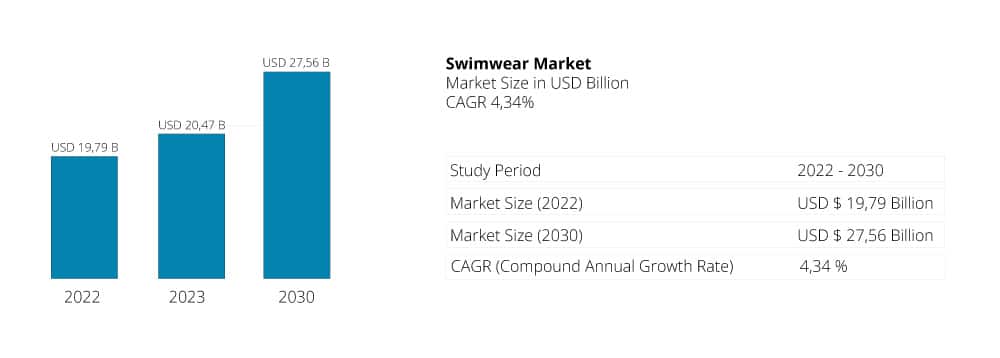
Claim Your Sampling Quotation
February 28, 2024
Launching Your Swimwear Line
April 3, 2024
Claim Your Sampling Quotation
February 28, 2024
Launching Your Swimwear Line
April 3, 2024Swimwear Market Research
Global Market Trends and Insights
Let's explore the dynamic swimwear industry, analyzing key market drivers and growth opportunities that will shape its future. With shifting societal attitudes towards body positivity and inclusivity, innovative designs are emerging to cater to diverse body types and preferences, indicating a promising future for the industry.

Leading Buyers of Swimwear: A Global Perspective
The swimwear market is experiencing robust growth, with projections indicating a steady rise in demand and revenue. According to recent research, the global swimwear market is expected to reach USD 27.56 billion by 2030, growing at an impressive annual rate of 4.34%.
This growth can be attributed to various factors, including changing fashion trends, increasing participation in water-based activities, and rising consumer awareness of sun protection. Additionally, advancements in fabric technology and design innovation are driving further expansion in the market.
In this dynamic market landscape, staying informed about emerging trends and consumer preferences is crucial for businesses looking to capitalize on opportunities and maintain a competitive edge. By leveraging market research insights, industry players can navigate challenges and drive sustainable growth in the vibrant swimwear market.
Exploring Top Swimwear Markets by Country
The country that emerges as the top buyer of swimwear can vary depending on various factors such as population size, cultural preferences, climate, and economic conditions. However, traditionally, countries with extensive coastlines, warm climates, and a strong beach culture tend to be significant consumers of swimwear.
Some of the countries commonly regarded as major buyers of swimwear include:
- United States: With its extensive coastline, warm weather in many regions, and a strong beach and pool culture, the United States is one of the largest markets for swimwear globally.
- Australia: Known for its beach-centric lifestyle and warm climate, Australia has a strong demand for swimwear, making it a significant market for both domestic and international brands.
- Brazil: Brazil's vibrant beach culture and warm climate make it a key market for swimwear, with a wide range of styles and designs catering to the diverse preferences of Brazilian consumers.
- European countries: Several European countries with coastal regions, such as Spain, Italy, France, and Greece, are also significant buyers of swimwear, particularly during the summer months when beach tourism is at its peak.
- Asian countries: Countries like Japan, South Korea, and Thailand have growing swimwear markets, driven by changing lifestyles, increasing disposable income, and the popularity of beach destinations among tourists.
These countries represent diverse markets with unique cultural, climatic, and economic factors influencing swimwear consumption. Understanding the preferences and trends in these key markets is crucial for swimwear brands aiming to expand their reach and capitalize on global opportunities.
Consumer Insights by Demographic
Swimwear Market Interest by Gender
- Women's Swimwear: Traditionally dominates the market, accounting for a significant majority of sales. This is due to a wide variety of styles and the importance of fashion in women’s swimwear.
- Men's Swimwear: Also represents a substantial market segment, with growing interest in fashion-forward and functional designs.
- Children's Swimwear: A smaller but important segment, driven by parents’ concerns for sun protection and durability.
Swimwear Market Interest by Age
- Young Adults (18-34 years): Likely the largest demographic, influenced by trends, social media, and a focus on fitness and leisure activities.
- Middle-Aged Adults (35-54 years): Also a significant segment, with disposable income for premium products and a preference for comfort, durability, and style.
- Seniors (55+ years): A smaller segment of the market, with specific needs in terms of comfort and functionality.
Current Trends in Swimwear Design
In today's ever-evolving fashion landscape, swimwear design plays a pivotal role in shaping consumer preferences and industry trends. Conducting thorough market research on the latest design innovations and emerging styles is essential for swimwear brands to stay competitive and relevant.
Moreover, sustainability is becoming increasingly important in swimwear design, with eco-friendly materials and production processes gaining traction. From recycled fabrics to environmentally conscious dyeing methods, brands are embracing sustainability as a core principle in their design ethos.
Another notable trend in swimwear design is inclusivity, with brands offering a diverse range of sizes, styles, and fits to cater to a wider audience. Body-positive messaging and campaigns are reshaping industry standards, promoting self-confidence and empowerment among consumers of all body types.
As the swimwear market continues to evolve, staying attuned to shifting consumer preferences and market dynamics is crucial for brands looking to thrive in this competitive landscape. By conducting comprehensive design research and embracing innovation, swimwear brands can captivate consumers with trend-setting designs that resonate with their target audience.
Understanding Consumer Behavior
Understanding consumer behavior is essential for success in the swimwear industry. Consider the following factors that influence consumer preferences and purchasing decisions:
- Preferred Styles: Explore the preferences of consumers regarding swimwear styles, such as one-piece vs. two-piece, bikini vs. tankini, and the popularity of specific designs or embellishments.
- Price Sensitivity: Assess the willingness of consumers to pay premium prices for designer swimwear compared to their interest in budget-friendly options, and how pricing impacts their purchasing decisions.
- Brand Loyalty: Investigate the extent to which consumers exhibit loyalty to established swimwear brands versus their openness to trying new or niche brands, and the factors influencing brand preference and trust.
- Shopping Preferences: Examine the preferred channels and methods of purchasing swimwear, including online vs. in-store shopping, the influence of social media and influencers, and seasonal vs. year-round buying patterns.
By gaining insights into these aspects, swimwear brands can tailor their strategies to better meet the needs and preferences of their target audience, ultimately driving growth and success in the market.
Rising Tide of Sustainable Swimwear

In recent years, a surge of environmental awareness has revolutionized the fashion industry, extending its influence into swimwear. With consumers becoming more environmentally conscious, there's a growing demand for eco-friendly and sustainable swimwear options.
This shift towards sustainability presents a significant opportunity for brands. Those that adopt eco-conscious practices are well-positioned to thrive in this evolving market. By prioritizing innovation, education, and collaboration, the swimwear sector can pave the way towards a more sustainable and ethically responsible future.
By understanding global market trends, consumer preferences, and emerging design concepts, you can position your swimwear brand for success in this ever-evolving landscape. Whether you're targeting specific demographics, exploring new markets, or embracing sustainability, the key is to stay informed, adaptable, and creative. Together, let's make waves in the swimwear industry and shape a future that's both fashionable and sustainable.




